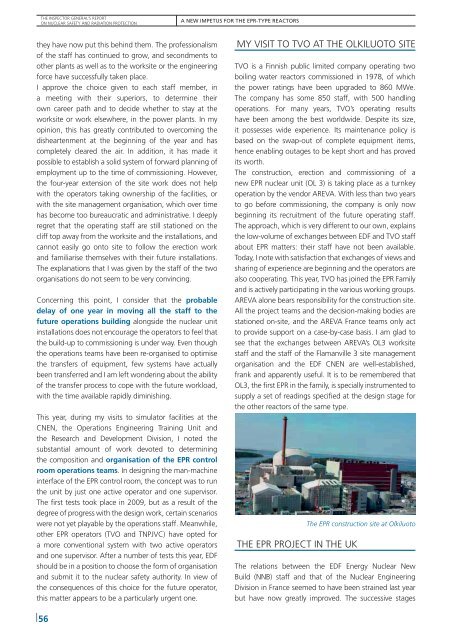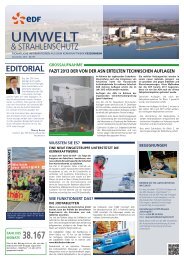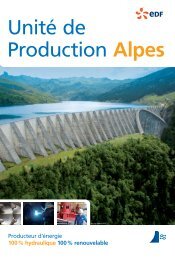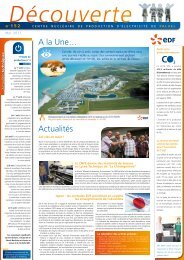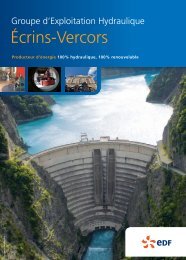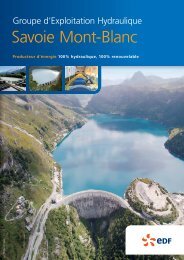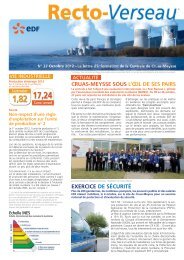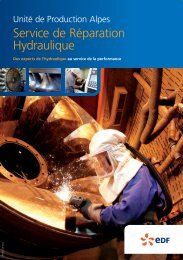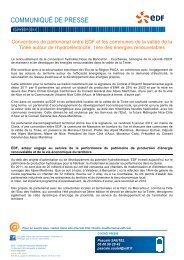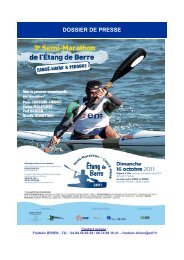on Nuclear Safety and Radiation Protection - Energie EDF
on Nuclear Safety and Radiation Protection - Energie EDF
on Nuclear Safety and Radiation Protection - Energie EDF
You also want an ePaper? Increase the reach of your titles
YUMPU automatically turns print PDFs into web optimized ePapers that Google loves.
THE INSPECTOR GENERAL’S REPORT<br />
ON NUCLEAR SAFETY AND RADIATION PROTECTION<br />
they have now put this behind them. The professi<strong>on</strong>alism<br />
of the staff has c<strong>on</strong>tinued to grow, <strong>and</strong> sec<strong>on</strong>dments to<br />
other plants as well as to the worksite or the engineering<br />
force have successfully taken place.<br />
I approve the choice given to each staff member, in<br />
a meeting with their superiors, to determine their<br />
own career path <strong>and</strong> to decide whether to stay at the<br />
worksite or work elsewhere, in the power plants. In my<br />
opini<strong>on</strong>, this has greatly c<strong>on</strong>tributed to overcoming the<br />
disheartenment at the beginning of the year <strong>and</strong> has<br />
completely cleared the air. In additi<strong>on</strong>, it has made it<br />
possible to establish a solid system of forward planning of<br />
employment up to the time of commissi<strong>on</strong>ing. However,<br />
the four-year extensi<strong>on</strong> of the site work does not help<br />
with the operators taking ownership of the facilities, or<br />
with the site management organisati<strong>on</strong>, which over time<br />
has become too bureaucratic <strong>and</strong> administrative. I deeply<br />
regret that the operating staff are still stati<strong>on</strong>ed <strong>on</strong> the<br />
cliff top away from the worksite <strong>and</strong> the installati<strong>on</strong>s, <strong>and</strong><br />
cannot easily go <strong>on</strong>to site to follow the erecti<strong>on</strong> work<br />
<strong>and</strong> familiarise themselves with their future installati<strong>on</strong>s.<br />
The explanati<strong>on</strong>s that I was given by the staff of the two<br />
organisati<strong>on</strong>s do not seem to be very c<strong>on</strong>vincing.<br />
C<strong>on</strong>cerning this point, I c<strong>on</strong>sider that the probable<br />
delay of <strong>on</strong>e year in moving all the staff to the<br />
future operati<strong>on</strong>s building al<strong>on</strong>gside the nuclear unit<br />
installati<strong>on</strong>s does not encourage the operators to feel that<br />
the build-up to commissi<strong>on</strong>ing is under way. Even though<br />
the operati<strong>on</strong>s teams have been re-organised to optimise<br />
the transfers of equipment, few systems have actually<br />
been transferred <strong>and</strong> I am left w<strong>on</strong>dering about the ability<br />
of the transfer process to cope with the future workload,<br />
with the time available rapidly diminishing.<br />
This year, during my visits to simulator facilities at the<br />
CNEN, the Operati<strong>on</strong>s Engineering Training Unit <strong>and</strong><br />
the Research <strong>and</strong> Development Divisi<strong>on</strong>, I noted the<br />
substantial amount of work devoted to determining<br />
the compositi<strong>on</strong> <strong>and</strong> organisati<strong>on</strong> of the EPR c<strong>on</strong>trol<br />
room operati<strong>on</strong>s teams. In designing the man-machine<br />
interface of the EPR c<strong>on</strong>trol room, the c<strong>on</strong>cept was to run<br />
the unit by just <strong>on</strong>e active operator <strong>and</strong> <strong>on</strong>e supervisor.<br />
The first tests took place in 2009, but as a result of the<br />
degree of progress with the design work, certain scenarios<br />
were not yet playable by the operati<strong>on</strong>s staff. Meanwhile,<br />
other EPR operators (TVO <strong>and</strong> TNPJVC) have opted for<br />
a more c<strong>on</strong>venti<strong>on</strong>al system with two active operators<br />
<strong>and</strong> <strong>on</strong>e supervisor. After a number of tests this year, <strong>EDF</strong><br />
should be in a positi<strong>on</strong> to choose the form of organisati<strong>on</strong><br />
<strong>and</strong> submit it to the nuclear safety authority. In view of<br />
the c<strong>on</strong>sequences of this choice for the future operator,<br />
this matter appears to be a particularly urgent <strong>on</strong>e.<br />
56<br />
A NEW IMPETUS FOR THE EPR-TYPE REACTORS<br />
MY VISIT TO TVO AT THE OLKILUOTO SITE<br />
TVO is a Finnish public limited company operating two<br />
boiling water reactors commissi<strong>on</strong>ed in 1978, of which<br />
the power ratings have been upgraded to 860 MWe.<br />
The company has some 850 staff, with 500 h<strong>and</strong>ling<br />
operati<strong>on</strong>s. For many years, TVO’s operating results<br />
have been am<strong>on</strong>g the best worldwide. Despite its size,<br />
it possesses wide experience. Its maintenance policy is<br />
based <strong>on</strong> the swap-out of complete equipment items,<br />
hence enabling outages to be kept short <strong>and</strong> has proved<br />
its worth.<br />
The c<strong>on</strong>structi<strong>on</strong>, erecti<strong>on</strong> <strong>and</strong> commissi<strong>on</strong>ing of a<br />
new EPR nuclear unit (OL 3) is taking place as a turnkey<br />
operati<strong>on</strong> by the vendor AREVA. With less than two years<br />
to go before commissi<strong>on</strong>ing, the company is <strong>on</strong>ly now<br />
beginning its recruitment of the future operating staff.<br />
The approach, which is very different to our own, explains<br />
the low-volume of exchanges between <strong>EDF</strong> <strong>and</strong> TVO staff<br />
about EPR matters: their staff have not been available.<br />
Today, I note with satisfacti<strong>on</strong> that exchanges of views <strong>and</strong><br />
sharing of experience are beginning <strong>and</strong> the operators are<br />
also cooperating. This year, TVO has joined the EPR Family<br />
<strong>and</strong> is actively participating in the various working groups.<br />
AREVA al<strong>on</strong>e bears resp<strong>on</strong>sibility for the c<strong>on</strong>structi<strong>on</strong> site.<br />
All the project teams <strong>and</strong> the decisi<strong>on</strong>-making bodies are<br />
stati<strong>on</strong>ed <strong>on</strong>-site, <strong>and</strong> the AREVA France teams <strong>on</strong>ly act<br />
to provide support <strong>on</strong> a case-by-case basis. I am glad to<br />
see that the exchanges between AREVA’s OL3 worksite<br />
staff <strong>and</strong> the staff of the Flamanville 3 site management<br />
organisati<strong>on</strong> <strong>and</strong> the <strong>EDF</strong> CNEN are well-established,<br />
frank <strong>and</strong> apparently useful. It is to be remembered that<br />
OL3, the first EPR in the family, is specially instrumented to<br />
supply a set of readings specified at the design stage for<br />
the other reactors of the same type.<br />
THE EPR PROJECT IN THE UK<br />
The EPR c<strong>on</strong>structi<strong>on</strong> site at Olkiluoto<br />
The relati<strong>on</strong>s between the <strong>EDF</strong> Energy <strong>Nuclear</strong> New<br />
Build (NNB) staff <strong>and</strong> that of the <strong>Nuclear</strong> Engineering<br />
Divisi<strong>on</strong> in France seemed to have been strained last year<br />
but have now greatly improved. The successive stages


